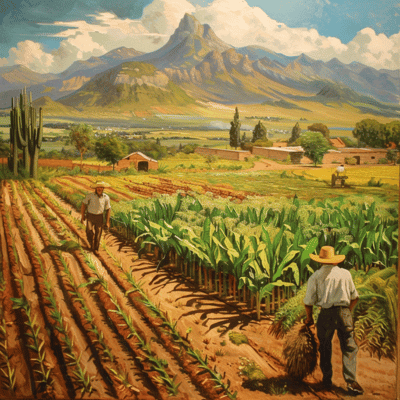The ejidos and agrarian communities are the form of land tenure that covers most of the surface in the Mexican countryside; these offer important agricultural and livestock production and most of the hills, forest areas, mangroves, coasts, water, mines and various natural attractions are in their lands
The ejido in Mexico
Mainly associated with the revolutionary agrarian reform, which projected the agrarian law of 1915 as collective, undivided land that could not be sold or inherited. Throughout the 20th century, its legislation underwent various changes, in accordance with the economic and political projects of the governments in power.
The key element to understanding the introduction of ejidos in Mexico as an integral part of the laws that followed the Mexican Revolution is the historical context in which the country found itself. Historian Emilio Kouri, in his article “The Invention of the Ejido”, speaks of the ejido as a social result of the Mexican armed struggle that was the revolution, but rather as a temporary response to the social demands of the revolution.
“That a revolution destroys what is unjust or does not work in order to try something new and different -with or without success- is the usual thing, and in the case of Mexico the agrarian reform of the Revolution invented the ejido. There should be no doubt that it is a modern invention, as will be seen below. The ejido was born as a provisional, almost accidental arrangement, but in less than two decades it was consolidated as the main instrument for governmental redistribution of land (...).
However, the ejido became a major piece in the policy of agrarian distribution in Mexico, more as a political tool to establish rural peace after the fall of Porfiriato than as an effective tool to fulfill the demands of the peasants; for the post-revolutionary war period, these aspects of communal restitution and indigenous property spaces provided by the creation of the ejidos resulted in a practical policy of control. In this regard, Kourí also mentions in his article the following:
“Thus, for both political and historical reasons, the solution to the agrarian problem at that time was clear: communal property was what the humblest people of the countryside (the Indians above all) understood best, what was most convenient to their present needs and, moreover, apparently, what the Zapatistas in arms on the other side of the Ajusco said they wanted(...).
January 6 marks a century since, in the midst of a great civil war, the Carrancista faction enacted an agrarian law in Veracruz that unintentionally marked the beginning and course of the most extensive agrarian reform in the modern history of Latin America. Throughout more than seven decades, the governments emanating from the Revolution gave way to an enormous transformation of the legal order and the social distribution of rural property in Mexico.
Pushed first by the demands and struggles of new peasant organizations and soon also by the irresistible attraction of its clientelist potential, the Revolution ended up distributing a lot of land, and not only bad land. Cardenismo (assisted by the Great Depression) broke up a good part of the large haciendas, demolishing without a second thought a long-lived economic and social institution that symbolized not only the consolidation of territorial property and local power since the mid-19th century, but also the legacy of conquests, subjections and viceregal depredations.
By 1991, when the Constitution was amended to put an end to the repartition, more than two-thirds of Mexico's land and forests had been subject to agrarian reform. There is much to debate about the costs and benefits, the vices and virtues, or the aspirations and failures of the Revolution's land distribution, but in any case, what is certain is that the magnitude of that institutional change in land ownership is comparable only to that which occurred as a result of the Spanish conquest in the sixteenth century.
El ejido, símbolo de la Revolución Mexicana*
Megathreads and spaces to hang out:
- 📀 Come listen to music and Watch movies with your fellow Hexbears nerd, in Cy.tube
- 🔥 Read and talk about a current topics in the News Megathread
- ⚔ Come talk in the New Weekly PoC thread
- ✨ Talk with fellow Trans comrades in the New Weekly Trans thread
- 👊 Share your gains and goals with your comrades in the New Weekly Improvement thread
- 🧡 Disabled comm megathread
reminders:
- 💚 You nerds can join specific comms to see posts about all sorts of topics
- 💙 Hexbear’s algorithm prioritizes comments over upbears
- 💜 Sorting by new you nerd
- 🌈 If you ever want to make your own megathread, you can reserve a spot here nerd
- 🐶 Join the unofficial Hexbear-adjacent Mastodon instance toots.matapacos.dog
Links To Resources (Aid and Theory):
Aid:
Theory:



Them for the last few years: YOU CAN'T JUST SAY AMERICAN IS FASCIST!
Me, holding blackshirts and reds in one hand, ur-fascism in the other, and balancing Fascism, a history on my head; Look here you little shits!
I already talked about this in another thread, but I think people rejecting that America is fascist aren't wrong. I just subscribe to Gabriel Rockhill's theory of multimodal governance where the state takes on liberalism as the hegemonic ideology then it also takes on fascism as an enforcement mechanism, simultaneously.
Idk who said it but "neoliberalism is rational fascism" got stuck with me
Nah I don't really want to discuss it, just gonna say that anything that upholds capitalism will slide into fascism eventually
That's just from the full title of Blackshirts and Reds.
Pretty sure that's Parenti because I'm reading that right now.
And yeah idk why you'd need to make a distinction between Liberalism as an ideology and fascism as an enforcement mechanism. Things are getting so arcane at that point I don't see a purpose to the distinction.
Frankly, I think we should have been a lot less restrictive with naming fascism a long time ago instead of waiting until it was at full power to name it. It's not like being coy and sticking to academic descriptions ended up helping at all.